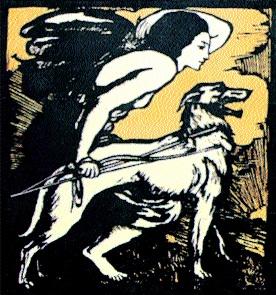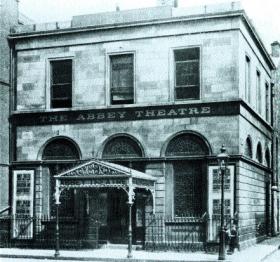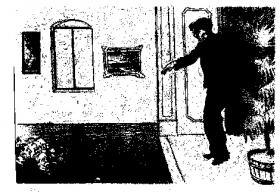The Abbey Theatre: the first hundred years
Published in 18th–19th - Century History, 20th-century / Contemporary History, Features, Features, Issue 1 (Spring 2004), Volume 12 At the beginning of its centenary year, the Abbey Theatre continues to play an important role in Irish cultural life. Just what this role should be and to what extent the Abbey lives up to the enormous expectations generated by its position as the National Theatre are questions which are alive today, much as they have been for most of the past century of its existence. John Lynch’s two-hour documentary, in RTÉ’s Arts Lives series, gave us a very interesting insight into how these questions, involving both artistic and national agendas, have always been part of the history of the Abbey and its place in Irish society. The film, like the Abbey itself, was an ambitious undertaking, as it sought to trace the changing history of the theatre largely through the words of the playwrights, actors and directors who were directly involved.
At the beginning of its centenary year, the Abbey Theatre continues to play an important role in Irish cultural life. Just what this role should be and to what extent the Abbey lives up to the enormous expectations generated by its position as the National Theatre are questions which are alive today, much as they have been for most of the past century of its existence. John Lynch’s two-hour documentary, in RTÉ’s Arts Lives series, gave us a very interesting insight into how these questions, involving both artistic and national agendas, have always been part of the history of the Abbey and its place in Irish society. The film, like the Abbey itself, was an ambitious undertaking, as it sought to trace the changing history of the theatre largely through the words of the playwrights, actors and directors who were directly involved.
The Abbey’s origins lie partly in the Anglo-Irish literary revival of the early 1900s associated with Yeats, Lady Gregory and J.M. Synge, and partly in a more widespread movement of change that swept across European drama at the end of the nineteenth century. The Théâtre Libre founded in Paris in 1887 and the Moscow Art Theatre of 1895 were movements of protest against a stale metropolitanism. In Russia, Danchenko and Stanislavski aspired to a ‘spiritual realism’, ‘a native Russian drama which should be representative of the younger generation, its aspirations and its resolves’. The founding of the Abbey in 1904 came at a moment when the energies of the European movement for free theatre combined with those of a gifted generation of Irish dramatists. The new theatre also grew out of a fusion of Yeats and Gregory’s Irish Literary Theatre with the Fay brothers’ Irish National Dramatic Company. The smallness of the Abbey stage, in the old Mechanics Institute building on Abbey Street, was no obstacle to the exciting things that were happening in Dublin in the Abbey’s first generation. Contributors evoked the intimacy of the old auditorium, with its perfect acoustic—factors that made up for the lack of basic facilities. The disturbances surrounding Synge’s Playboy in 1907 and O’Casey’s The Plough and the Stars in 1926 were testimony to the ground-breaking nature of what was being achieved, and to the courage of the Abbey management in the face of public criticism. Indeed, the Abbey’s early support for O’Casey showed that it was capable of producing a new kind of drama addressing the difficult birth pangs of independent Ireland in the 1920s. O’Casey later regretted the personal split caused by the rejection of The Silver Tassie—but even Yeats had a play rejected by the Abbey in 1938.
 The O’Casey controversy was a prelude to the gradual change in the Abbey’s fortunes during the 1920s and 1930s. Certainly by the late 1920s the Abbey had an international reputation, and 1931 saw the beginning of the long American tours which consolidated this but which may also have contributed to the increasing lack of dynamism that affected the Abbey in its middle decades. Fund-raising had always been a problem, and in 1924 Yeats and Lady Gregory obtained an annual subsidy of £850 from the Irish Free State. Ernest Blythe, then finance minister, joined the board and became increasingly dominant over the next 40 years, eventually serving as both managing director and artistic director. Blythe brought a stifling paternalism and a narrow view of what an Irish National Theatre should be. Vincent Dowling recalled Blythe’s statement that the Abbey was not just a theatre but an instrument of national defence. The iron qualities that had won the civil war and guided the embattled state were not those required to foster the kind of creative engagement with modern theatre that had made the Abbey in the first place. Much of the running in the middle decades of the century was made by the Gate companies, but there is little sense in the documentary of the wider world of Irish theatre in the period between the 1930s and the 1960s.
The O’Casey controversy was a prelude to the gradual change in the Abbey’s fortunes during the 1920s and 1930s. Certainly by the late 1920s the Abbey had an international reputation, and 1931 saw the beginning of the long American tours which consolidated this but which may also have contributed to the increasing lack of dynamism that affected the Abbey in its middle decades. Fund-raising had always been a problem, and in 1924 Yeats and Lady Gregory obtained an annual subsidy of £850 from the Irish Free State. Ernest Blythe, then finance minister, joined the board and became increasingly dominant over the next 40 years, eventually serving as both managing director and artistic director. Blythe brought a stifling paternalism and a narrow view of what an Irish National Theatre should be. Vincent Dowling recalled Blythe’s statement that the Abbey was not just a theatre but an instrument of national defence. The iron qualities that had won the civil war and guided the embattled state were not those required to foster the kind of creative engagement with modern theatre that had made the Abbey in the first place. Much of the running in the middle decades of the century was made by the Gate companies, but there is little sense in the documentary of the wider world of Irish theatre in the period between the 1930s and the 1960s.
The fire of 1951 forced the Abbey into an exile lasting fifteen years in the Queen’s Theatre, Pearse Street. This period was evoked by T.P. McKenna and others as one of stagnation. Audiences were fed a diet of undemanding light comedies, and a kind of serio-comic pastiche of the Abbey’s classic repertoire. Rehearsals were short, set design was basic and the impression was conveyed of the increasing frustration of talented actors forced to work in a restrictive environment for very little money, culminating in a successful actors’ strike in 1963. The strike was the beginning of the end of Blythe’s reign. He resigned after the opening of the long-awaited new building on Abbey Street in 1966. Michael Scott defended his design by arguing that he had sought to preserve the intimacy of the original building, but few who spoke in the film agreed. Nevertheless 1966 was another turning-point.
After 1966 a succession of artistic directors, each seeking to make a mark, engaged with the existing traditions of the Abbey. Lelia Doolan, Joe Dowling, Patrick Mason, Gary Hynes and others brought to the Abbey a sense of engagement with the wider Irish and contemporary theatrical worlds. Frank McGuinness remarked that the modern Abbey is as much the product of the artistic directors as of the actors and playwrights. The emergence of a galaxy of new playwrights also worked a slow but increasingly impressive transformation on the Abbey from the 1970s as it became more open to the great increase in Irish dramatic writing. The Peacock, perhaps because of its smaller scale, often seems to have been the real seedbed of new talent. Among all these positive changes, the permanent company was the principal casualty. It seemed to be taken for granted in the film that the permanent company could not survive in the new conditions of innovation and experiment demanded by successive directors and authors.

Tom Lalor cartoon of Yeats addressing the audience from the stage of the Abbey during the Playboy disturbances, 1907. (National Library of Ireland)
As we came closer to the present, the film’s narrative was increasingly, perhaps justifiably, focused on achievement. Certainly a succession of brilliant productions of an increasingly impressive repertoire of new Irish writers such as Murphy, Friel and McGuinness, combined with innovations in direction and production, provided the main themes. Stephen Rea’s contribution stood out as the only serious criticism of the directions taken and not taken in recent decades. Though the film understandably concentrated on the Abbey to the exclusion of much else around it, the overall impression was not one of complacency. Many of the contributors conveyed almost painfully the sense of responsibility and the tensions that accompany the custody of a national institution, long after the reasons for its foundation have become part of history. Tradition and innovation will always be difficult companions, and the national theatre will always be a more public institution than many others. The Abbey now faces a new era as it prepares to rebuild on the site of the original theatre—or possibly elsewhere?
John Lynch’s film had the merit of concentrating on the words of the participants—actors, authors and directors—illustrated by archive clips from productions and surviving parts of earlier documentaries. The connecting narrative was bland and unobtrusive, which was appropriate given the obvious engagement of all those who spoke. Turbulence, restlessness and conflict seem to be the ideal conditions for the health of the Abbey Theatre, even in its centenary year.
Eamon O’Flaherty lectures in history at University College Dublin.
















